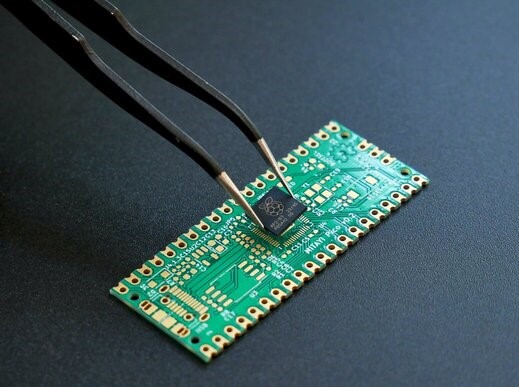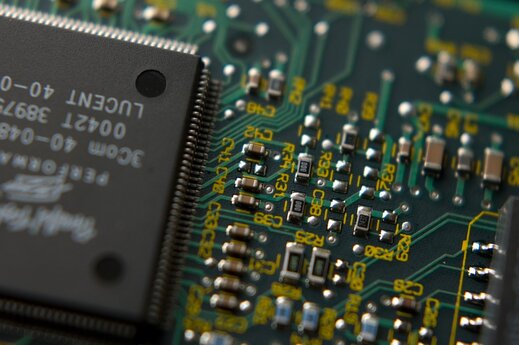
Semiconductors are materials that have a conductivity between conductors and non-conductors. The conductivity of a semiconductor can be modified and controlled by introducing impurities or defects into the crystal structure of the material. Some examples of semiconductors are- silicon, germanium, gallium arsenide and indium phosphide. Silicon and gallium arsenide are the most common semiconductors.
ALSO READ- Fibonacci Pattern of 12 Jyotirlingas
Some common uses of semiconductors categorised by their applications-
- Electronics:
- Microprocessors: Serving as the computational powerhouse in computers and smartphones, handling complex tasks and calculations.
- Memory Chips: Storing data in electronic devices, ranging from temporary RAM to permanent flash memory.
- Communication:
- Transistors: Amplifying and switching electrical signals, crucial for communication devices.
- Optoelectronics: Enabling fibre-optic communication and laser diodes, vital components in modern optical networks.
- Consumer Electronics:
- Integrated Circuits (ICs): Empowering various devices like TVs, gaming consoles, and digital cameras with processing capabilities.
- Diodes: Facilitating the conversion of AC to DC power in chargers and adapters for electronic gadgets.
- Renewable Energy:
- Solar Cells: Converting sunlight into electricity, a primary technology used in photovoltaic panels.
- Power Electronics: Managing and optimizing energy conversion in renewable energy systems.
- Automotive:
- Automotive ICs: Controlling engine functions, safety systems, and vehicle infotainment features.
- Sensors: Monitoring tyre pressure, airbag deployment, and other critical vehicle parameters.
- Aerospace and Defense:
- Radar Technology: Incorporating semiconductor components for advanced radar systems.
- GPS Navigation: Relying on semiconductors for precise global positioning and navigation.
- Healthcare and Medical Devices:
- Medical Imaging: Utilizing semiconductor sensors in X-ray and MRI machines for diagnostic purposes.
- Biosensors: Detecting and analyzing biological substances, essential in medical testing and diagnostics.
- Internet of Things (IoT):
- Microcontrollers: Controlling and managing IoT devices with low power consumption and efficiency.
- Wireless Communication: Enabling seamless data exchange and connectivity in various IoT applications.
- Artificial Intelligence (AI):
- GPUs: Accelerating AI training and processing tasks through high-performance parallel computation.
- Neural Network Processors: Specialized hardware designed to enhance AI computations and neural network training.
- Industrial Applications:
- Process Control: Employing semiconductor sensors and chips to monitor and regulate manufacturing processes.
- Motor Drives: Utilizing semiconductor devices to control motor speed and torque in industrial equipment.

A semiconductor is so useful, maybe that’s why today every country is running after semiconductors. In the Indian context, its own consumption of semiconductors is expected to cross $80 bn by 2026 and to $110 bn by 2030. That’s why India is also taking steps in this direction.
India’s efforts towards semiconductors-
- The cabinet approved a PLI scheme in Dec 2021. $10 bn (₹76000 cr.) would be spent on this scheme in 6 years.
- In Sept 2022, Indian company ‘Vedanta’ and Taiwanese company ‘Foxconn’ started a joint project worth $19.5 bn in the field of semiconductors but in July 2023 Foxconn pulled out from this project. However, Foxconn is planning to start a new project in India with another partner.
- Indian govt. reopened $10 bn incentives to semiconductor manufacturing firms in May 2023.
- Indian govt. organised a mega event named “Semicon India 2023” from 28 July to 30 July at Gandhinagar, Gujrat.
- Top news from this event-
- Indian govt. announced that it would give ‘50% offers’ to manufacturing firms.
- It would start semiconductor education in 300 colleges.
- American company AMD announced to invest $400 mn over 5 years in Bengaluru.
- Top news from this event-
Conclusion-
India is trying its best so that India can become a semiconductor manufacturing hub but it is also true that India will need a huge investment for this mainly from the giants of this field like TSMC, Intel etc.
